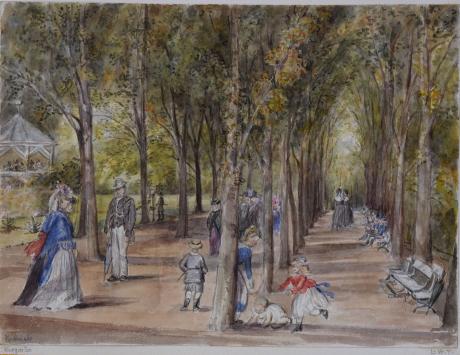inbscribed "Neuenahrer Kurgarten " and signed with initials "LWT"
Tom and Laura Taylor and thence by descent
The Gardens and Park in Neuenahr are still in use today.
The Neuenahrer Berg in the area of the town of Bad Neuenahr-Ahrweiler in the Ahrweiler district in Rhineland-Palatinate is 340 m above sea level. high elevation in the northern Eifel. The ruins of Neuenahr Castle and a lookout tower are located on it. The Neuenahrer Berg is located immediately south of the district town of Bad Neuenahr-Ahrweiler and is considered its local mountain. At the northern foot of the mountain, the Ahr flows in a west-east direction. Geologically, the Neuenahrer Berg is a hard rock that remained as a basalt cone, which was eroded by the Ur-Ahr from a Devonian cover made of greywacke that was arched up in the Tertiary. Some outcrops of columnar basalt can be seen in the summit area. Neuenahr Castle on the summit, which Count Otto von Neuenahr had built on the mountain in the 13th century, was destroyed in a feud in 1372 on the instructions of the Cologne Archbishop Friedrich III. of Saar are destroyed by citizen shooters from Ahrweiler. After the male line of counts died out, robber barons established themselves there. A round observation tower made of reinforced concrete was built on the castle grounds in 1972. There is also a modern Eifelverein pavilion there.
Bad Neuenahr-Ahrweiler rests in the Ahr valley (German: Ahrtal) on the left bank of the Rhine river in the north of Rhineland-Palatinate. Bad Neuenahr-Ahrweiler nestles in the Ahr Hills (German: Ahrgebirge).
The highest hill in the area is the Häuschen at 506 metres (1,660 ft) metres above sea level. Nearby are the hills of Steckenberg, Neuenahrer, and Talerweiterung. There used to be castles on the last two of these hills.
Bad Neuenahr-Ahrweiler is surrounded by the following villages and towns (clockwise from the north): Grafschaft, Remagen, Sinzig, Königsfeld, Schalkenbach, Heckenbach, Kesseling, Rech and Dernau. The nearest cities are Bonn and Koblenz.
Bad Neuenahr is divided into Ortsbezirke which consist of one or more districts. The Ortsbezirke are represented by local councils. The largest district, Bad Neuenahr, was originally made up of three communities, which are still seen as districts.
Discoveries dating to the Hallstatt period (1000–500 BC) show farming activity by Celts that dwelled in the area. The Gallic Wars (58–50 BC) resulted in the forced relocation of the indigenous Eburones to the Middle Rhine. Several Roman discoveries date from the 1st to 3rd centuries. Most notable is the Villa Rustica of Bad Neuenahr
In 893 AD, Ahrweiler was mentioned as Arwilre, Arewilre, Arewilere, and later Areweiller in the Prüm Urbar (register of estates owned by Prüm Abbey). The abbey of Ahrweiler owned a manor with 24 farmsteads; 50 acres of farmland and 76 acres of vineyards. The first mention of a parish church occurred in Neuenahr Castle and surrounding county (Newenare) from 1204 to 1225. In 1246 was founded one of the oldest German inns Gasthaus Sanct Peter.
Laura Wilson Barker (6 March 1819 – 22 May 1905), was a composer, performer and artist, sometimes also referred to as Laura Barker, Laura W Taylor or "Mrs Tom Taylor".
She was born in Thirkleby, North Yorkshire, third daughter of a clergyman, the Rev. Thomas Barker. She studied privately with Cipriani Potter and became an accomplished pianist and violinist. As a young girl Barker performed with both Louis Spohr and Paganini. She began composing in the mid-1830s - her Seven Romances for voice and guitar were published in 1837. From around 1843 until 1855 she taught music at York School for the Blind. During this period some of her compositions - including a symphony in manuscript, on 19 April 1845 - were performed at York Choral Society concerts.
On 19 June 1855 she married the English dramatist, critic, biographer, public servant, and editor of Punch magazine Tom Taylor. Barker contributed music to at least one of her husband's plays, an overture and entr'acte to Joan of Arc (1871), and provided harmonisations as an appendix to his translation of Ballads and Songs of Brittany (1865).
Her other works include the cantata Enone (1850), the violin sonata A Country Walk (1860), theatre music for As You Like It, (April 1880), Songs of Youth (1884), string quartets, madrigals and solo songs. Her choral setting of Keats's A Prophecy, composed in 1850, was performed for the first time 49 years later at the Hovingham Festival in 1899. The composer was present.
Several of Barker's paintings hang at Smallhythe Place in Kent, Ellen Terry's house.
Barker lived with her husband and family at 84 Lavender Sweep, Battersea. There were two children: the artist John Wycliffe Taylor (1859–1925), and Laura Lucy Arnold Taylor (1863–1940). The Sunday musical soirees at the house attracted many well-known attendees, including Lewis Carroll, Charles Dickens, Henry Irving, Charles Reade, Alfred Tennyson, Ellen Terry and William Makepeace Thackeray.
Tom Taylor died suddenly at his home in 1880 at the age of 62. After his death, his widow retired to Porch House, Coleshill in Buckinghamshire, where she died on 22 May 1905, aged 86.

